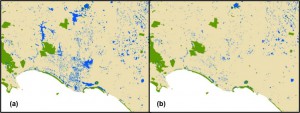Wetland functions and the growing need for conservation in South Western Victoria
Thousands of wetlands are scattered across south-western Victoria making them a defining landscape feature, and these systems support a unique diversity of flora and fauna. Since European settlement more than 7800 (53%) of the region’s wetlands have been lost due to agricultural practices. This has greatly impacted the availability and connectivity of habitat for wetland specialist species, in many cases leading to their decline. A notable example is the iconic native Brolga (Grus rubicunda), which was once prolific throughout the region but has been reduced to 200-250 nesting pairs. Wetland ecosystems are now facing further threats due to drought and projected reductions in rainfall based on climate change models. Therefore there is an increasing urgency for environmental planning to conserve and restore these vulnerable habitats and their inhabitants.
Almost 80 per cent of wetlands remaining in South Western Victoria are in private ownership. Consequently, conservation and restoration works depend on cooperation from private land owners. There is an increasing awareness among the agricultural community of the ecological services wetlands provide and also the associated socioeconomic benefits, including flood buffering, preserving and improving water quality, and maintaining surface water flow during dry periods. Consequently NGT are working with a growing number of land users across the region to secure wetland habitats. From our experience so far it is extremely encouraging to see how many people are passionate about wetland health and how quickly wetland ecosystems respond positively to even modest restoration investments. Please refer to the Wetland Restoration on Private land, Long Swamp Restoration or Brady and Gooseneck Swamp blog this week about the current restoration efforts in the Southern Grampians for more information – it’s been a rewarding and busy few months!



